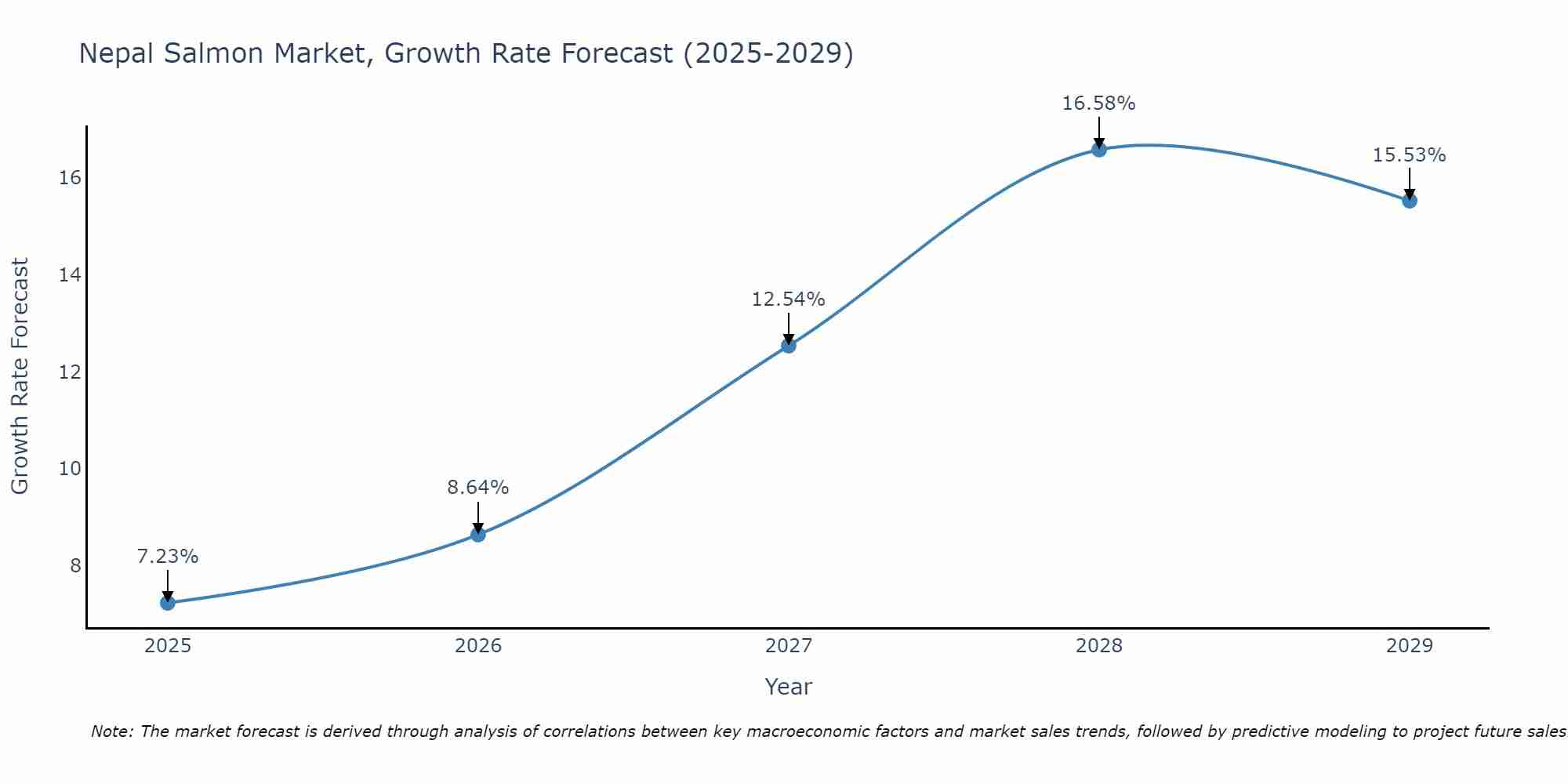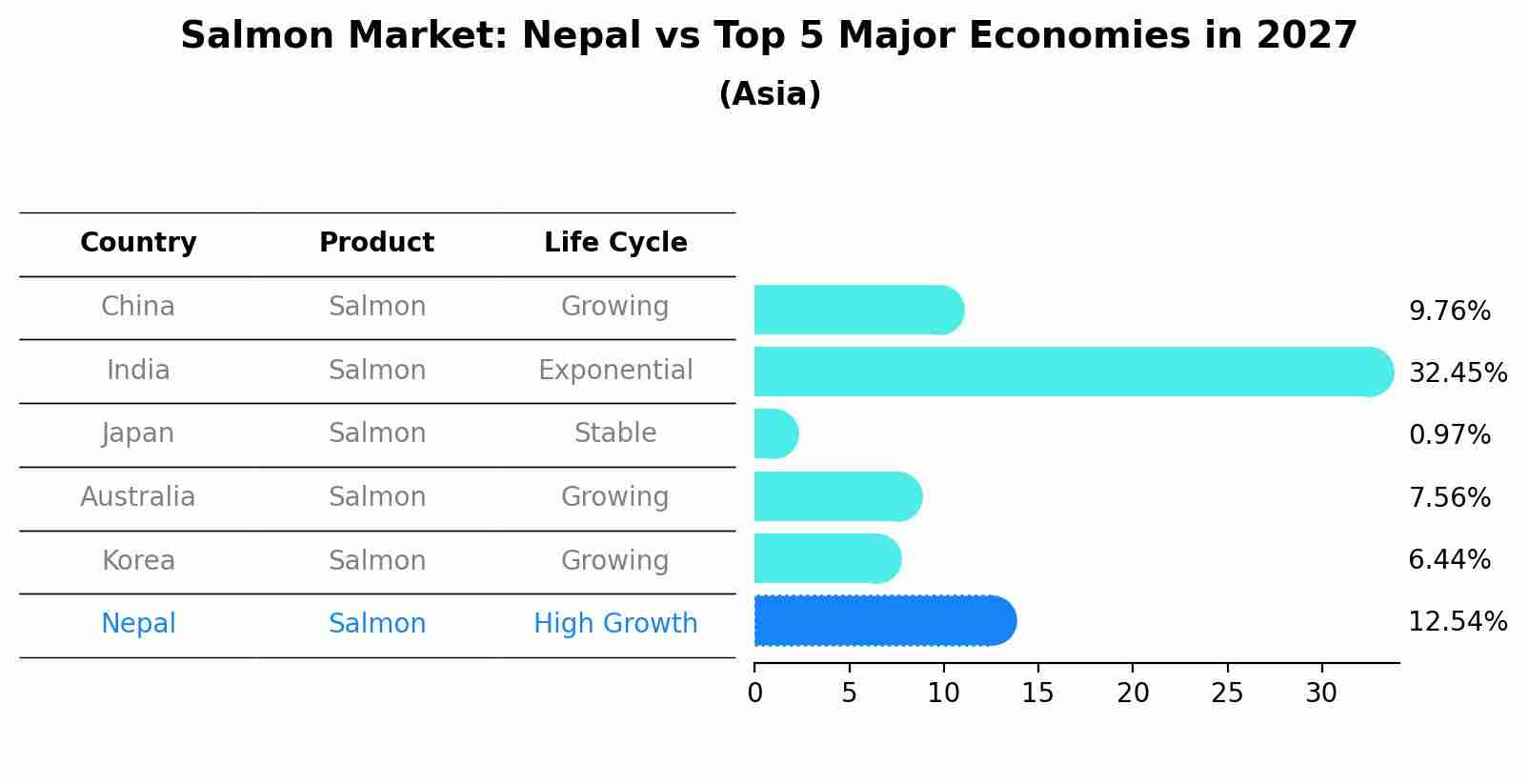Nepal Salmon Market (2025-2031) Outlook | Revenue, Growth, Industry, Size, Share, Value, Analysis, Forecast, Companies & Trends
| Product Code: ETC387636 | Publication Date: Aug 2022 | Updated Date: Jul 2025 | Product Type: Market Research Report | |
| Publisher: 6Wresearch | Author: Shubham Deep | No. of Pages: 75 | No. of Figures: 35 | No. of Tables: 20 |
Nepal Salmon Market Size Growth Rate
The Nepal Salmon Market is projected to witness mixed growth rate patterns during 2025 to 2029. The growth rate begins at 7.23% in 2025, climbs to a high of 16.58% in 2028, and moderates to 15.53% by 2029.

Salmon Market: Nepal vs Top 5 Major Economies in 2027 (Asia)
By 2027, the Salmon market in Nepal is anticipated to reach a growth rate of 12.54%, as part of an increasingly competitive Asia region, where China remains at the forefront, supported by India, Japan, Australia and South Korea, driving innovations and market adoption across sectors.

Nepal Salmon Market Synopsis
The Nepal salmon market is a niche segment within the broader seafood industry in the country. Despite not being a traditional staple in Nepalese cuisine, salmon has gained popularity among the urban population and expatriates living in Nepal due to its health benefits and versatile culinary applications. The market primarily caters to high-end restaurants, hotels, and expat communities, with imported salmon being the dominant source due to limited local production. As consumer awareness about the nutritional value and taste of salmon grows, there is potential for further market expansion. However, challenges such as high import costs, limited availability, and competition from other seafood products remain key factors influencing the growth of the Nepal salmon market.
Nepal Salmon Market Trends
The Nepal Salmon Market is experiencing a growing trend towards sustainable and eco-friendly practices. Consumers are increasingly looking for responsibly sourced salmon that is ethically produced and environmentally friendly. There is also a rising demand for premium quality salmon products, with a focus on freshness and taste. Additionally, health-conscious consumers are seeking out salmon for its numerous health benefits, such as being rich in omega-3 fatty acids and protein. This has led to an increase in the availability of organic and wild-caught salmon options in the market. Overall, the Nepal Salmon Market is moving towards catering to more discerning consumers who prioritize sustainability, quality, and health benefits in their seafood choices.
Nepal Salmon Market Challenges
In the Nepal Salmon Market, challenges primarily include limited availability of fresh salmon due to the landlocked nature of the country, resulting in high import costs and potential quality issues from transportation. Additionally, consumer awareness and preference for salmon as a seafood option may be low compared to other local fish varieties, leading to limited demand. Infrastructure constraints, such as cold chain logistics and storage facilities, also pose challenges in maintaining the quality and freshness of imported salmon. Furthermore, pricing pressure from competing seafood products in the market and fluctuating exchange rates can impact the affordability and profitability of salmon offerings, creating barriers for market growth and expansion in Nepal.
Nepal Salmon Market Investment Opportunities
The Nepal Salmon Market presents promising investment opportunities due to increasing demand for high-quality seafood products in the region. With a growing middle-class population and rising consumer awareness about the health benefits of salmon, there is a potential for strong market growth. Investors can consider opportunities in salmon farming operations, distribution networks, processing facilities, and retail outlets catering to the growing demand for salmon products. Additionally, strategic partnerships with international seafood suppliers and investment in sustainable aquaculture practices can further enhance the market potential in Nepal. Overall, the Nepal Salmon Market offers a fertile ground for investors seeking to capitalize on the expanding market for premium seafood products in the region.
Jordan Agar Market Government Policies
Government policies related to the Nepal Salmon Market primarily focus on promoting sustainable fishing practices, ensuring the conservation of salmon populations, and regulating the fishing industry to prevent overfishing. The government has implemented measures such as licensing requirements for fishermen, setting catch limits, and establishing protected areas for salmon breeding. Additionally, there are regulations in place to monitor the quality and safety of salmon products for consumers. The government also supports research and development initiatives to enhance the productivity and sustainability of the salmon market. Overall, these policies aim to balance the economic benefits of the salmon industry with environmental conservation efforts to ensure the long-term viability of the Nepal Salmon Market.
Nepal Salmon Market Future Outlook
The future outlook for the Nepal Salmon Market appears promising with potential growth opportunities. As global demand for seafood continues to rise, there is increasing interest in diversifying the types of fish available in the market. Salmon is known for its health benefits and high nutritional value, making it a popular choice among consumers. With advancements in aquaculture technology and sustainable farming practices, the production of salmon in Nepal is expected to increase, leading to a more competitive market and potentially lower prices for consumers. Additionally, the growing trend of health-conscious eating habits and the rise of the middle-class population in Nepal are likely to drive further demand for salmon in the coming years, presenting a positive outlook for the market`s growth and development.
Key Highlights of the Report:
- Nepal Salmon Market Outlook
- Market Size of Nepal Salmon Market, 2024
- Forecast of Nepal Salmon Market, 2031
- Historical Data and Forecast of Nepal Salmon Revenues & Volume for the Period 2021 - 2031
- Nepal Salmon Market Trend Evolution
- Nepal Salmon Market Drivers and Challenges
- Nepal Salmon Price Trends
- Nepal Salmon Porter's Five Forces
- Nepal Salmon Industry Life Cycle
- Historical Data and Forecast of Nepal Salmon Market Revenues & Volume By Type for the Period 2021 - 2031
- Historical Data and Forecast of Nepal Salmon Market Revenues & Volume By Chinook Salmon for the Period 2021 - 2031
- Historical Data and Forecast of Nepal Salmon Market Revenues & Volume By Coho Salmon for the Period 2021 - 2031
- Historical Data and Forecast of Nepal Salmon Market Revenues & Volume By Pink Salmon for the Period 2021 - 2031
- Historical Data and Forecast of Nepal Salmon Market Revenues & Volume By Red Salmon for the Period 2021 - 2031
- Historical Data and Forecast of Nepal Salmon Market Revenues & Volume By Salmo Salar for the Period 2021 - 2031
- Historical Data and Forecast of Nepal Salmon Market Revenues & Volume By Silverbrite Salmon for the Period 2021 - 2031
- Historical Data and Forecast of Nepal Salmon Market Revenues & Volume By End Product Type for the Period 2021 - 2031
- Historical Data and Forecast of Nepal Salmon Market Revenues & Volume By Fresh for the Period 2021 - 2031
- Historical Data and Forecast of Nepal Salmon Market Revenues & Volume By Frozen for the Period 2021 - 2031
- Historical Data and Forecast of Nepal Salmon Market Revenues & Volume By Canned for the Period 2021 - 2031
- Historical Data and Forecast of Nepal Salmon Market Revenues & Volume By Others for the Period 2021 - 2031
- Historical Data and Forecast of Nepal Salmon Market Revenues & Volume By Distribution Channel for the Period 2021 - 2031
- Historical Data and Forecast of Nepal Salmon Market Revenues & Volume By Retail Stores for the Period 2021 - 2031
- Historical Data and Forecast of Nepal Salmon Market Revenues & Volume By Hypermarket/supermarket for the Period 2021 - 2031
- Historical Data and Forecast of Nepal Salmon Market Revenues & Volume By Online Sales Channels for the Period 2021 - 2031
- Nepal Salmon Import Export Trade Statistics
- Market Opportunity Assessment By Type
- Market Opportunity Assessment By End Product Type
- Market Opportunity Assessment By Distribution Channel
- Nepal Salmon Top Companies Market Share
- Nepal Salmon Competitive Benchmarking By Technical and Operational Parameters
- Nepal Salmon Company Profiles
- Nepal Salmon Key Strategic Recommendations
Frequently Asked Questions About the Market Study (FAQs):
- Single User License$ 1,995
- Department License$ 2,400
- Site License$ 3,120
- Global License$ 3,795
Search
Related Reports
- Europe Flooring Market (2025-2031) | Outlook, Share, Industry, Trends, Forecast, Companies, Revenue, Size, Analysis, Growth & Value
- Saudi Arabia Manlift Market (2025-2031) | Outlook, Size, Growth, Trends, Companies, Industry, Revenue, Value, Share, Forecast & Analysis
- Uganda Excavator, Crane, and Wheel Loaders Market (2025-2031) | Strategy, Consumer Insights, Analysis, Investment Trends, Opportunities, Growth, Size, Share, Industry, Revenue, Segments, Value, Segmentation, Supply, Forecast, Restraints, Outlook, Competition, Drivers, Trends, Demand, Pricing Analysis, Competitive, Strategic Insights, Companies, Challenges
- Rwanda Excavator, Crane, and Wheel Loaders Market (2025-2031) | Strategy, Consumer Insights, Analysis, Investment Trends, Opportunities, Growth, Size, Share, Industry, Revenue, Segments, Value, Segmentation, Supply, Forecast, Restraints, Outlook, Competition, Drivers, Trends, Demand, Pricing Analysis, Competitive, Strategic Insights, Companies, Challenges
- Kenya Excavator, Crane, and Wheel Loaders Market (2025-2031) | Strategy, Consumer Insights, Analysis, Investment Trends, Opportunities, Growth, Size, Share, Industry, Revenue, Segments, Value, Segmentation, Supply, Forecast, Restraints, Outlook, Competition, Drivers, Trends, Demand, Pricing Analysis, Competitive, Strategic Insights, Companies, Challenges
- Angola Excavator, Crane, and Wheel Loaders Market (2025-2031) | Strategy, Consumer Insights, Analysis, Investment Trends, Opportunities, Growth, Size, Share, Industry, Revenue, Segments, Value, Segmentation, Supply, Forecast, Restraints, Outlook, Competition, Drivers, Trends, Demand, Pricing Analysis, Competitive, Strategic Insights, Companies, Challenges
- Israel Intelligent Transport System Market (2025-2031) | Strategy, Consumer Insights, Analysis, Investment Trends, Opportunities, Growth, Size, Share, Industry, Revenue, Segments, Value, Segmentation, Supply, Forecast, Restraints, Outlook, Competition, Drivers, Trends, Demand, Pricing Analysis, Competitive, Strategic Insights, Companies, Challenges
- Uganda Precast and Aggregate Market (2025-2031) | Strategy, Consumer Insights, Analysis, Investment Trends, Opportunities, Growth, Size, Share, Industry, Revenue, Segments, Value, Segmentation, Supply, Forecast, Restraints, Outlook, Competition, Drivers, Trends, Demand, Pricing Analysis, Competitive, Strategic Insights, Companies, Challenges
- Australia IT Asset Disposal Market (2025-2031) | Strategy, Consumer Insights, Analysis, Investment Trends, Opportunities, Growth, Size, Share, Industry, Revenue, Segments, Value, Segmentation, Supply, Forecast, Restraints, Outlook, Competition, Drivers, Trends, Demand, Pricing Analysis, Competitive, Strategic Insights, Companies, Challenges
- UAE Building Thermal Insulation Market Outlook (2025-2031) | Revenue, Companies, Share, Trends, Growth, Size, Forecast, Industry, Analysis & Value
Industry Events and Analyst Meet
Our Clients
Whitepaper
- Middle East & Africa Commercial Security Market Click here to view more.
- Middle East & Africa Fire Safety Systems & Equipment Market Click here to view more.
- GCC Drone Market Click here to view more.
- Middle East Lighting Fixture Market Click here to view more.
- GCC Physical & Perimeter Security Market Click here to view more.
6WResearch In News
- Doha a strategic location for EV manufacturing hub: IPA Qatar
- Demand for luxury TVs surging in the GCC, says Samsung
- Empowering Growth: The Thriving Journey of Bangladesh’s Cable Industry
- Demand for luxury TVs surging in the GCC, says Samsung
- Video call with a traditional healer? Once unthinkable, it’s now common in South Africa
- Intelligent Buildings To Smooth GCC’s Path To Net Zero













